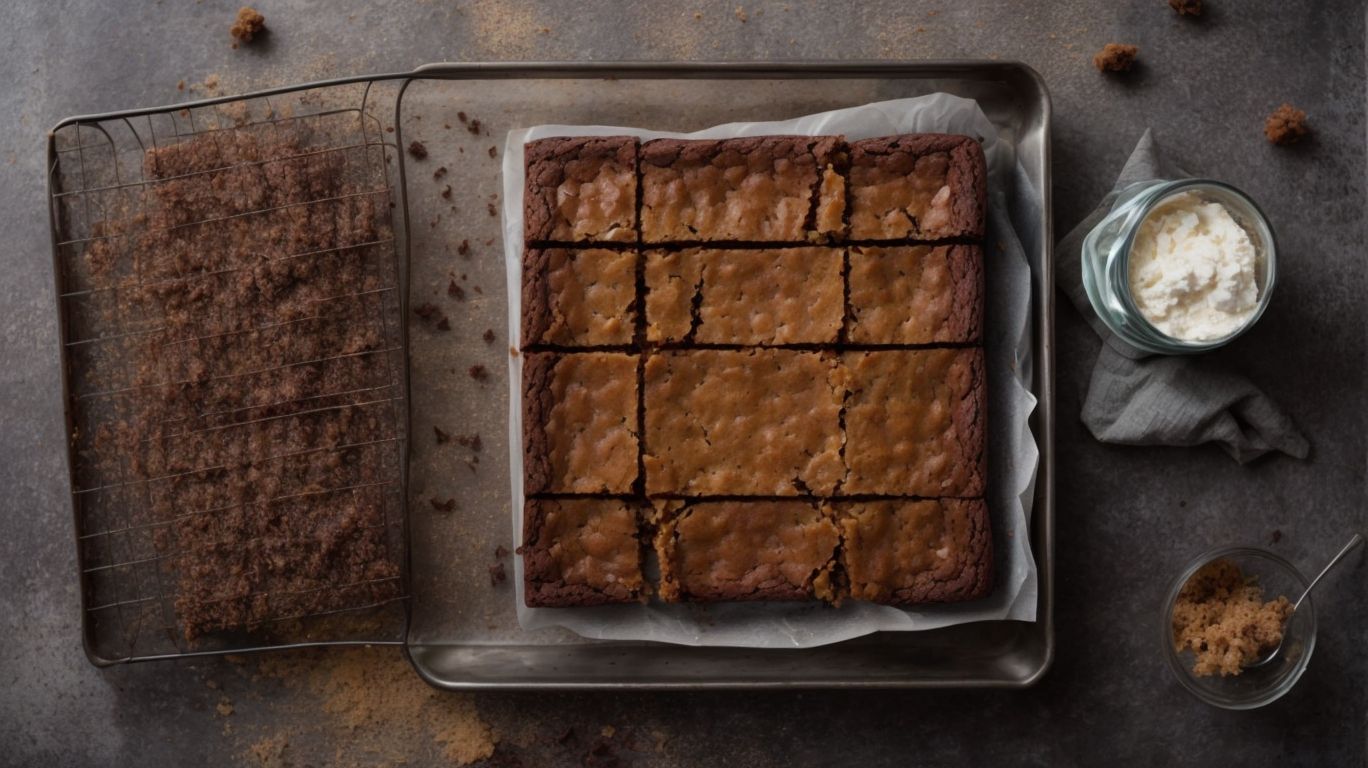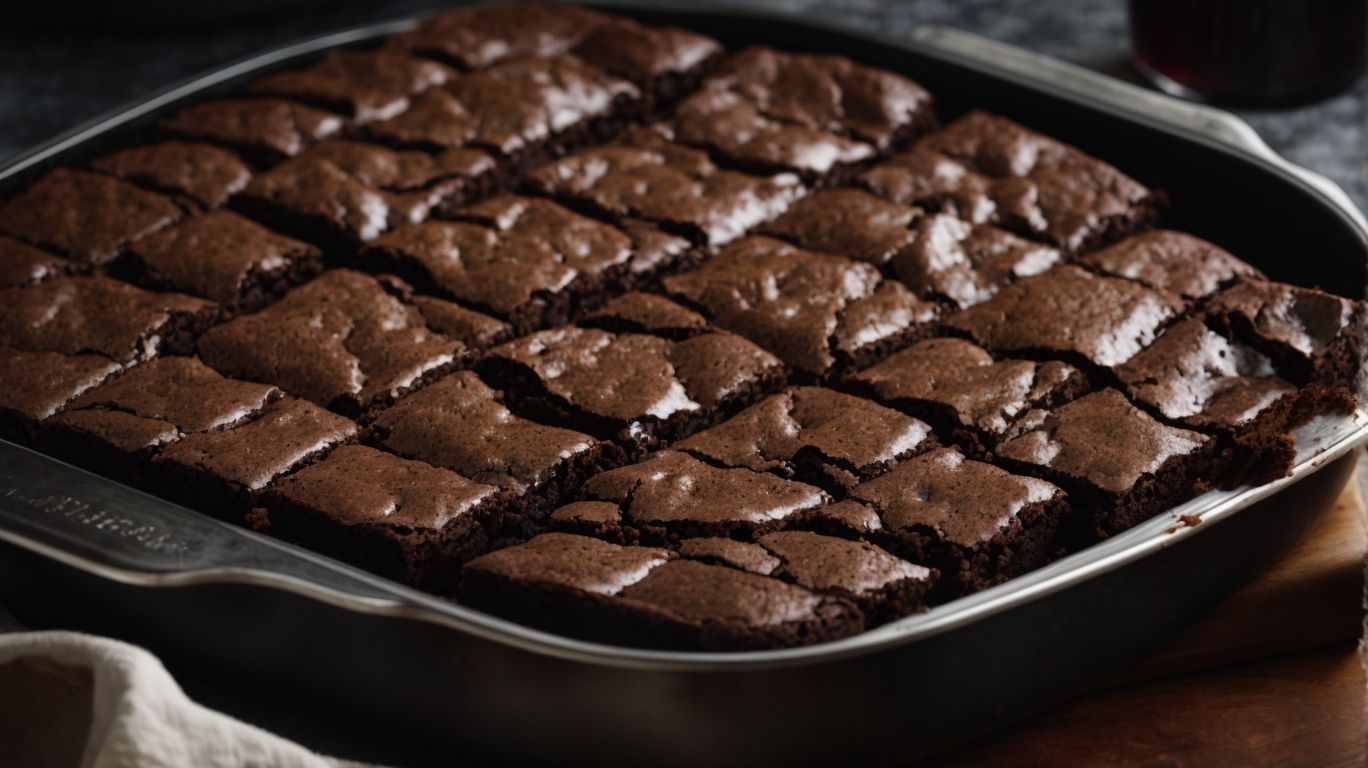How to Bake Brownies Without Hard Edges?
Love baking brownies but always end up with those dreaded hard edges?
Exploring what brownies are, why they get hard edges, and most importantly, sharing valuable tips on how to bake brownies without those unwelcome edges.
From using a glass baking dish to adjusting the ingredients, we have got you covered.
We will also discuss how to tell when your brownies are perfectly baked and offer some final thoughts on finding your ultimate brownie recipe.
Let’s get baking!
Key Takeaways:
What Are Brownies?
Brownies are delectable, rich desserts that combine the goodness of chocolate, fudgy texture, and a satisfyingly sweet taste.
These delightful treats are made using a variety of ingredients, including:
- cocoa powder
- butter
- sugar
- flour
- eggs
The combination of these elements results in a dense and moist texture, with a perfect balance between gooey and cake-like consistency.
The flavor profile of brownies is a harmonious blend of deep cocoa notes, richness from the butter, and sweetness from the sugar. The chocolate flavor shines through, creating a decadent experience with every bite.
Why Do Brownies Get Hard Edges?
The hard edges of brownies often result from specific baking techniques and variations in oven temperature during the baking process.
When baking brownies, the edges tend to cook faster than the center due to their direct exposure to the heat sources in the oven. This can lead to the edges becoming crispy and firm while the center remains soft and fudgy.
One way to prevent this is by reducing the oven temperature slightly and extending the baking time, allowing for more even cooking throughout the brownie batch. Using a higher quality baking pan can help distribute heat more evenly, resulting in a more consistent texture across the brownies.
Tips for Baking Brownies Without Hard Edges
To achieve perfectly baked brownies without hard edges, consider implementing various tips and techniques that enhance the baking process.
Use a Glass Baking Dish
Using a glass baking dish is a recommended technique to prevent brownies from developing hard edges and ensuring even baking.
One of the key benefits of a glass baking dish for brownie preparation is its ability to distribute heat evenly throughout the batter. Glass is an excellent conductor of heat, allowing for consistent temperature across the dish, which helps in avoiding hot spots that can lead to unevenly baked brownies. The uniform heat distribution results in brownies that are perfectly cooked from edge to center.
Glass baking dishes offer the advantage of preventing excessive browning or burning on the edges of the brownies. The thermal properties of glass help in gently cooking the edges, leading to a soft and chewy texture, rather than a hard crust that metal pans may produce.
Line the Baking Dish with Parchment Paper
Lining the baking dish with parchment paper is a useful tip to avoid hard edges on brownies and facilitate easy removal from the pan.
One of the key advantages of using parchment paper when baking brownies is its exceptional non-stick properties. This means that your freshly baked treats will effortlessly release from the paper, ensuring perfectly shaped brownies without any sticking or tearing. Moreover, parchment paper acts as a protective barrier for the edges of your brownies, preventing them from becoming overly crisp or burnt during baking. The convenience that parchment paper offers by minimizing cleanup and simplifying the overall baking process makes it a must-have tool for any avid baker.
Lower the Oven Temperature
Lowering the oven temperature can help prevent hard edges on brownies by promoting slower and more even baking.
When baking brownies, adjusting the oven temperature plays a crucial role in achieving the desired texture and consistency. By lowering the temperature, you allow the batter to set gradually, resulting in a moist and fudgy center. This technique also helps in reducing the risk of overcooking the edges while ensuring a soft and chewy outcome. A lower oven temperature contributes to a more controlled heat distribution, leading to uniform baking across the entire pan.
Bake for a Shorter Time
Reducing the baking time slightly can prevent brownies from developing hard edges and ensure a softer, moister texture.
When baking brownies, the baking duration plays a crucial role in determining the final outcome. If the baking time is too long, the edges of the brownies can become tough and dry. With a slight reduction in baking time, you can achieve a perfect balance, resulting in a gooey interior and a slightly chewy exterior. This careful management of baking time also influences the overall texture of the brownies, ensuring they are neither undercooked nor overbaked. It’s essential to keep an eye on the edges, as they can easily become brittle and detract from the overall enjoyment of the brownies.
Add an Extra Egg Yolk
Incorporating an additional egg yolk into the brownie batter can enhance moisture retention and contribute to softer edges.
When adding extra egg yolk to the brownie batter, the additional fat content from the yolk helps create a richer and more tender texture, giving your brownies a melt-in-your-mouth quality. The yolk also acts as a natural emulsifier, binding the ingredients together for a smoother consistency.
The extra egg yolk increases the overall moisture levels in the batter, resulting in a fudgier and denser final product. This is especially beneficial for those who prefer their brownies to be moist and chewy.
Use a Water Bath
Employing a water bath technique in baking can help regulate temperature and prevent hard edges on brownies by ensuring gentle, consistent heat.
A water bath involves placing the baking dish with the brownie batter into a larger pan filled with hot water.
The hot water serves as a buffer, distributing heat evenly around the brownie pan.
This gentle and indirect heat keeps the baking environment moist, preventing the edges of the brownies from becoming overly dry or crispy.
By maintaining a stable temperature, the water bath aids in creating a uniform and creamy texture throughout the brownies, without any cracks or uneven browning.
Adjust the Ingredients
Modifying the ingredients in the brownie batter, such as incorporating almonds, can lead to softer edges and a unique flavor profile.
Almonds not only add a delightful crunch to brownies but also bring a significant textural enhancement. When finely ground, almonds contribute to a smoother batter consistency, resulting in a velvety mouthfeel in every bite. The natural oils in almonds play a crucial role in moistness retention, preventing the brownies from becoming dry. By adjusting the amount of almonds in the recipe, you can customize the flavor profile, whether opting for a subtle nuttiness or a more pronounced almond taste.
How to Tell When Brownies are Done Baking

Credits: Poormet.Com – Roger Carter
Determining the ideal baking point for brownies involves assessing key indicators such as texture, aroma, and visual cues to achieve the perfect balance of fudginess and doneness.
The Toothpick Test
Performing the toothpick test involves inserting a toothpick into the center of the brownie to check for moist crumbs, indicating the perfect level of doneness.
This method is a foolproof way to avoid overbaking, which can result in dry and tough brownies.
To perform the test, make sure to use a clean toothpick to prevent any contamination. Gently insert it into the center of the brownie and remove it after a few seconds. If the toothpick comes out with a few moist crumbs attached, your brownies are ready to be taken out of the oven.
Remember, it’s better to slightly underbake than to overbake, as brownies continue to cook while they cool down.
The “Jiggle” Test
The “jiggle” test involves gently shaking the baking dish to observe the brownie’s center movement, indicating the right level of fudginess and doneness.
In the world of baking, the jiggle test serves as a reliable indicator of a brownie’s readiness straight from the oven. When shaking the dish, you are looking for a subtle wobble in the center, which signifies a moist and gooey texture – the hallmark of a perfectly baked brownie. This method not only ensures optimal fudginess but also helps prevent over-baking, keeping the brownies from becoming dry and crumbly.
The Visual Cue Test
The visual cue test involves observing the brownie’s edges for a slight crust formation and a shiny, set center to determine baking completion.
Another essential aspect to look for during the visual cue test is the center texture. A properly baked brownie should have a tender, moist crumb in the center but not appear raw or undercooked. The overall browning of the brownie’s top surface is a key indicator of even heat distribution and thorough baking. It should be a rich, golden-brown color, signaling caramelization of sugars for that perfect blend of flavors and textures.
Conclusion
Mastering the art of baking brownies without hard edges requires a blend of precise techniques, quality ingredients, and strategic adjustments to achieve the perfect balance of texture and flavor.
One key tip to avoid hard edges is to line the baking pan with parchment paper; this simple step not only prevents sticking but also promotes even baking.
Another crucial aspect is the proper use of leavening agents like baking powder or soda, which help in achieving the ideal rise and softness.
Consider modifying the recipe by adjusting the sugar and fat content to suit your preference, ensuring a customized taste profile.
Experimenting with ingredients such as dark chocolate chunks or a dash of espresso powder can bring depth and richness to your brownies.
Experiment and Find Your Perfect Brownie Recipe
Embark on a delightful culinary journey to discover your ideal brownie recipe by experimenting with different chocolate varieties, fudgy textures, and baking techniques.
From rich and dark cocoa-based brownies to creamy milk chocolate-infused treats, there is a world of flavors to explore. You can play with ingredients like nuts, caramel, or even fruits to add a unique twist to your brownie creation.
Customizing your recipe to suit your taste preferences or dietary requirements opens up endless possibilities in the realm of baking. Whether you prefer gooey centers or crispy edges, adjusting baking times and temperatures can help achieve the perfect texture for your brownies.
Frequently Asked Questions
Can I bake brownies without getting hard edges?
Yes, you can! There are a few tricks you can use to prevent hard edges when baking brownies.
What causes brownies to have hard edges?
Brownies get hard edges when the edges of the pan are exposed to direct heat. This causes them to cook faster and become crispy.
How do I prevent hard edges when baking brownies?
One way to prevent hard edges is by using a glass baking dish instead of a metal one. Glass will distribute heat more evenly, resulting in softer edges.
What else can I do to prevent hard edges when baking brownies?
You can also cover the edges of the brownies with foil during the last few minutes of baking. This will shield them from direct heat and keep them from getting too crispy.
Is there a way to make brownies with no edges at all?
Yes, you can make brownie bites by baking the batter in a mini muffin tin. Since there are no edges, the brownies will have a soft and chewy texture throughout.
Can I still get a fudgy texture without hard edges?
Definitely! Another way to achieve a fudgy texture without hard edges is by reducing the baking time by a few minutes. This will result in a gooier center and softer edges.

